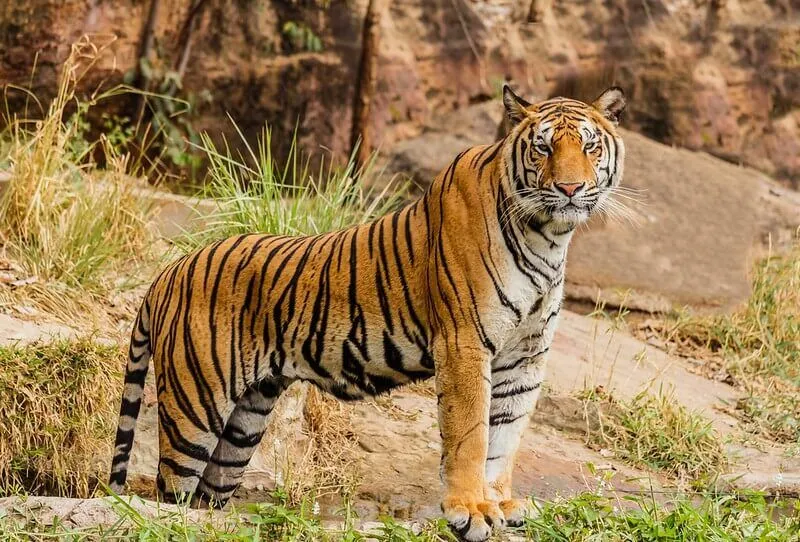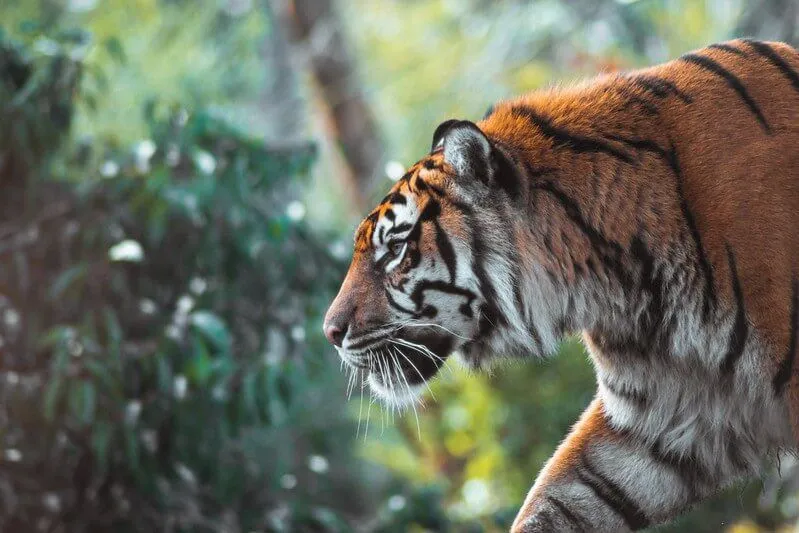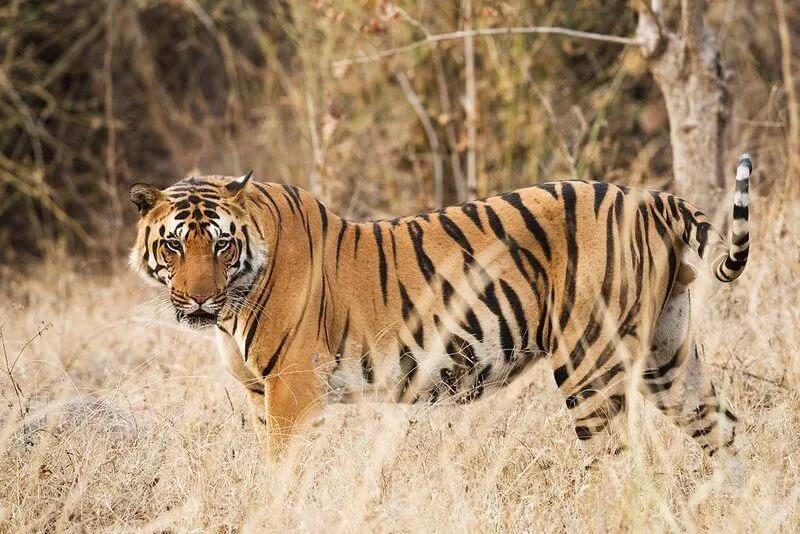FOR ALL AGES
Did you know that 29th July is International Tiger Day?
Though it may just sound like the coolest holiday ever, International Tiger Day was actually created to raise awareness about these amazing animals and the dangers they face in the modern world. So, try taking our tiger quiz to learn some more about these majestic cats and why their protection is so important.
a) 2 hundred years
b) 2 thousand years
c) 2 million years
a) Asia
b) Europe
c) Africa
a) Indonesia
b) China
c) India

a) Giraffe and antelope
b) Deer and wild boar
c) Zebra and hippopotamuses

a) 9
b) 6
c) 3
a) less than 50,000
b) less than 10,000
c) less than 5,000

1. True. Tigers are the largest cats out there - that means they grow bigger than leopards, cheetahs, and even lions. Male tigers tend to be heavier than females, and their size and weight vary from species to species. Siberian tigers can grow up to 3.3 metres from head to tail and weigh as much as 363kg. That's the weight of about ten 10-year-old children, combined!
Did you know? A tiger's tail can grow to over a metre long. They use it to help them balance, especially when making sharp turns as they hunt their prey.
2. c) 2 million years. That's right - ancient fossil remains of an extinct tiger species found in China show that these magnificent creatures have been roaming the earth for roughly two million years.
3. a) Asia. All wild tigers live in Asia, though many more are kept in captivity across the world. They can be found in India, China, Russia, Bangladesh, Thailand, Nepal, Bhutan, Myanmar, Laos, Cambodia, Vietnam, Malaysia and Indonesia.
Did you know? There are more tigers living in captivity in the USA than there are left in the wild.
4. c) India. About 3,000 of the world's wild tigers live in India. That's more than two-thirds of all wild tigers in the world!
Since 2014, the Indian government and conservation experts have worked hard to prevent poaching and increase local understanding of these beautiful cats and their habits. As a result, the Indian tiger population has risen by 33% in the past few years. Amazing news - but there's still so much more to be done!

5. b) Deer and wild boar. Tigers are carnivorous, which means they feed on other animals. They mostly hunt medium-sized mammals such as deer and wild boar, but they have been known to go for moose, buffalo and even elephant and rhinoceros calves.
Did you know? Tigers have soft pads on the base of their feet, allowing them to soundlessly sneak up on their victims.
6. False. Once a tiger is grown up, it will live and hunt alone.
Though they can sprint if necessary, tigers can't chase their prey for long distances like cheetahs can. For this reason, they tend to stalk and ambush their victims. Generally preferring to hunt at night, tigers will roam great distances in search of food, often covering 6-12 miles in a night's hunt. Once they have their prey in sight, they silently stalk towards it until close enough to pounce, when they lunge and kill with a lethal bite to the head or neck. Amazingly, a tiger's teeth have pressure-sensing nerves that can tell exactly where they need to bite to kill their prey. How cool is that?
Though tigers are certainly strong and stealthy, their skills aren't always enough to secure them a meal. In fact, they only succeed in catching their prey about 10% of the time. Luckily, a good catch (such as a large deer) can provide them with a week's worth of food.
Did you know? A tiger's eyesight is six times more powerful than a human's.
7. Tigers are pretty adaptable animals and can live in many different kinds of habitats - everywhere from freezing snow forests to tropical rainforests, grasslands, savannas and mangrove swamps.
8. True. Just like a human fingerprint, the stripy pattern on a tiger's coat is completely unique. The colour of the stripes can be different too, ranging from black to light brown depending on the species, and the pattern doesn't always look the same on each side of the tiger's body.
9. False. Unlike house cats, tigers love to swim, and can often be spotted cooling off in lakes, ponds and rivers. They can even hunt in water.

10. b) 6. There were originally nine subspecies of tiger, though only six remain today. These are the Siberian tiger, Bengal tiger, South China tiger, Sumatran tiger, Indo-Chinese tiger and the Malayan tiger.
Did you know? Sadly, the Javan, Caspian and Bali tigers have all been hunted into extinction. This could soon be true of other species. There are between 30 - 80 South China tigers left, and all of them live in captivity.
11. c) Less than 5,000. Actually, there is thought to be only about 3,900 tigers left in the wild. That's why the work of conservationists (people who work to protect wildlife) is so important.
12. Because of humans. Over the past 150 years, the habitat that tigers depend on to survive has been destroyed by humans, shrinking by almost 95%.
Tigers are also illegally hunted by poachers, who sell their skins and body parts in countries where they are used in traditional medicines or displayed as a symbol of wealth.
Did you know that tigers have been around for over 2 million years? Or that there are more in captivity than in the wild? We'll be honest, until we wrote this quiz, we certainly didn't. No matter how many answers you got right, hopefully you learned something new about these iconic cats. If you're keen to help spread the word for International Tiger Day, why not share your knowledge with your friends, present what you've learned to your class, or even get involved in sponsoring conservation efforts? It's an important issue, so let's hear you roar about it!
Header Image: iStock
Read The Disclaimer
At Kidadl we pride ourselves on offering families original ideas to make the most of time spent together at home or out and about, wherever you are in the world. We strive to recommend the very best things that are suggested by our community and are things we would do ourselves - our aim is to be the trusted friend to parents.
We try our very best, but cannot guarantee perfection. We will always aim to give you accurate information at the date of publication - however, information does change, so it’s important you do your own research, double-check and make the decision that is right for your family.
Kidadl provides inspiration to entertain and educate your children. We recognise that not all activities and ideas are appropriate and suitable for all children and families or in all circumstances. Our recommended activities are based on age but these are a guide. We recommend that these ideas are used as inspiration, that ideas are undertaken with appropriate adult supervision, and that each adult uses their own discretion and knowledge of their children to consider the safety and suitability.
Kidadl cannot accept liability for the execution of these ideas, and parental supervision is advised at all times, as safety is paramount. Anyone using the information provided by Kidadl does so at their own risk and we can not accept liability if things go wrong.
Kidadl is independent and to make our service free to you the reader we are supported by advertising.
We hope you love our recommendations for products and services! What we suggest is selected independently by the Kidadl team. If you purchase using the buy now button we may earn a small commission. This does not influence our choices. Please note: prices are correct and items are available at the time the article was published.
Kidadl has a number of affiliate partners that we work with including Amazon. Please note that Kidadl is a participant in the Amazon Services LLC Associates Program, an affiliate advertising program designed to provide a means for sites to earn advertising fees by advertising and linking to amazon.
We also link to other websites, but are not responsible for their content.
Was this article helpful?



Browse Category



We’ll send you tons of inspiration to help you find a hidden gem in your local area or plan a big day out.



Check your inbox for your latest news from us. You have subscribed to:
Remember that you can always manage your preferences or unsubscribe through the link at the foot of each newsletter.